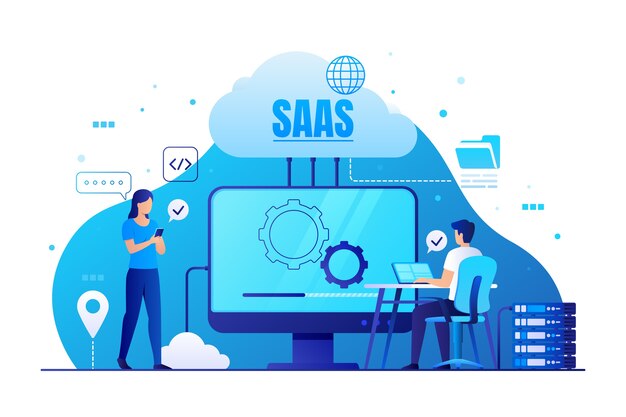Content Marketing for SaaS Business
How to start your Content Marketing?
First step in starting your content marketing is to define your ideal customer. Knowing your audience will help you tailor your content to their specific needs and pain points. Next, establish clear and measurable goals for your content marketing efforts. Are you aiming to generate leads, drive website traffic, or increase brand awareness?
Once you’ve set your goals, it’s time to choose the right content formats. Consider your target audience’s preferences. Do they prefer blog posts, videos, interactive content or infographics?
Effective content distribution is crucial for reaching your target audience. Leverage social media platforms, email marketing, and industry communities to share your content. Finally, track and analyze the performance of your content marketing efforts. Use analytics tools to measure key metrics such as website traffic, lead generation, and social media engagement.

Pinpointing Your Ideal Customer
For SaaS companies to thrive in the competitive digital landscape, understanding your target audience is paramount. This requires going beyond basic demographics and delving into their pain points, motivations, and content consumption habits. Are they primarily on LinkedIn? Do they prefer long-form blog posts or short, engaging videos? This granular understanding will inform every aspect of your content strategy.
Next by identifying the terms your ideal customers use when searching for solutions, you can tailor your content to rank higher in search engine results pages (SERPs). Leverage SEO tools to uncover relevant keywords related to your audience needs, what they are searching for online and industry trends.Incorporate relevant keywords like “SaaS,” “content marketing,” and “B2B content marketing” naturally throughout your content.

Pinpoint Your SaaS Content Marketing Objectives
Before diving into SAAS Content Marketing, clarify your goals. Are you aiming for increased brand awareness, lead generation, or customer retention? Defining your target audience is equally crucial. What are their pain points? What information do they seek?
Plan Your Content Strategy
- Focus on creating high-quality, informative, and engaging content that caters to your target audience’s needs. Explore current B2B content marketing trends to ensure your content remains relevant and resonates with your audience.
- A content calendar provides a roadmap for your content creation efforts. Plan and schedule your blog posts, case studies, and social media updates in advance.
- Promote your content across various channels, including social media, email marketing, and industry forums.
- Regularly analyze the performance of your content marketing efforts. Use data to identify areas for improvement and optimize your strategy accordingly.
- Repurpose existing content into different formats, such as videos, infographics, or podcasts. Update outdated content with fresh insights and statistics to maintain its relevance. This approach ensures your content remains valuable and aligns with current B2B Content Marketing Trends.
Crafting and Disseminating High-Value Content
With a clear picture of your audience and their preferred keywords, the next step is creating high-quality content that resonates. Consider diverse formats like blog posts, case studies, webinars, and infographics. Don’t underestimate the power of writing tools such as Rava AI to enhance your content creation process. Finally, a well-defined distribution strategy is crucial. Promote your content across relevant channels, including social media, email marketing, and industry publications, to maximize reach and engagement.

A Deep Dive into Content for SaaS
Content marketing attracts and engages potential customers as they navigate the buyer’s journey. For SaaS companies, it’s particularly crucial because of its ability to generate leads, build brand authority, and ultimately drive subscriptions.
Successfully marketing SaaS products in the B2B landscape requires a nuanced understanding of your target audience and their pain points. Creating valuable, informative content that resonates with these needs is paramount. Think blog posts addressing industry challenges, case studies showcasing successful implementations, and webinars offering expert insights.
Emerging trends in the B2B content marketing realm, such as AI-powered content marketing prompts and AI writing assistants like Rava AI, are changing how we approach content creation. These tools empower marketers to streamline content production, personalize messaging, and enhance content quality.
Aligning sales and marketing efforts is crucial for maximizing your GTM tech stack’s impact. When sales and marketing work in harmony, content becomes a powerful tool for nurturing leads and moving them through the sales funnel.
Attract More Qualified Leads with Your SaaS
Content Marketing keeps your audience engaged long after they convert. By providing valuable resources and ongoing support, you build strong customer relationships and foster loyalty. Explore different formats like case studies and testimonials to showcase the value of your SaaS.
Valuable content, like blog posts, ebooks, and webinars, attracts your ideal customer. By addressing their pain points and offering solutions, you establish your brand as a trusted resource and naturally guide them through the sales funnel.
Consistently publishing high-quality content positions your SaaS as an industry authority.

Winning Strategies for SaaS Content in 2024
Dominating the digital landscape is crucial for SaaS success, and content marketing is your strongest weapon. B2B content marketing for SaaS demands a laser focus on your ideal customer. Speak their language, address their pain points, and offer valuable solutions through various formats like blog posts, case studies, and webinars.
Leveraging technology can significantly elevate your content game. AI marketing assistants like Rava AI are transforming the way marketers create compelling content, from generating AI-powered content marketing prompts to crafting high-converting copy.
Don’t underestimate the power of a robust GTM tech stack to streamline your sales and marketing alignment. By integrating your tools and data, you can personalize your messaging and optimize your content for each stage of the buyer’s journey. Stay ahead of the curve by embracing B2B content marketing trends and harnessing the power of AI for sales enablement.
SaaS vs. Traditional: How is it different?
SaaS content marketing, unlike traditional strategies, focuses on building long-term relationships with potential customers. It’s about providing value, educating your audience, and establishing your SaaS as a solution to their problems.
- Consistency is key in SAAS Content marketing. However, quality trumps quantity. Focus on delivering high-value content that resonates with your target audience, whether it’s blog posts, case studies, or webinars. Experiment to find your optimal posting frequency.
- Optimizing your SaaS content for search engines is crucial. Conduct thorough keyword research to understand what your target audience is searching for. Integrate relevant keywords naturally within your content, optimize meta descriptions, and build high-quality backlinks.
- Creating compelling content is crucial for any SaaS company in the competitive B2B landscape. Ignoring current B2B content marketing trends can hinder your progress.
- Focusing on vanity metrics instead of ROI-driven results is a common trap. Track metrics that matter like leads generated and conversions.
- Content creation is only half the battle. Don’t underestimate the power of AI-powered content marketing prompts to streamline your workflow and boost creativity. By leveraging these tools, you can free up time to focus on other critical aspects of your GTM tech stack, like sales and marketing alignment. Remember that data-driven decisions are key to successful content marketing. Utilize analytics and optimization tools to track key metrics, understand what resonates with your audience, and refine your strategy for optimal impact.
- The most effective content marketing for SaaS leverages a diverse mix. Think blog posts tackling industry pain points, engaging videos, in-depth white papers, and interactive webinars. Don’t forget case studies showcasing your SaaS success stories.
- Measuring the effectiveness of your SaaS content marketing efforts requires tracking key metrics. Monitor website traffic, lead generation, social media engagement, and ultimately, customer acquisition cost. Tools like Google Analytics can provide valuable insights.
The SaaS landscape thrives on effective content marketing. For SaaS marketers and business owners, staying ahead of the curve with B2B Content Marketing trends is crucial. Compelling content is king in the B2B world, especially for SaaS content marketing. By embracing these strategies, you can drive engagement, nurture leads, and ultimately accelerate growth.







